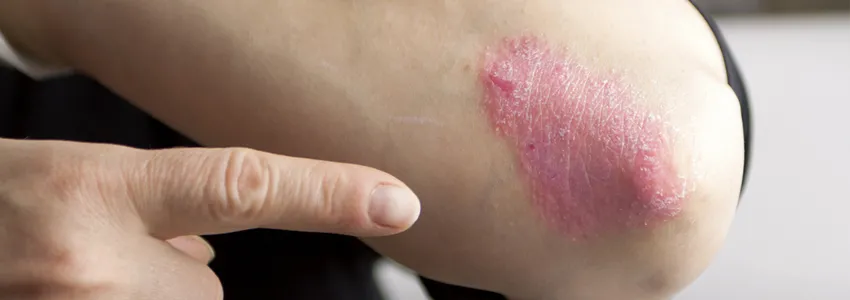
Photo by Hriana, Shutterstock: Psoriasis, a genetic disease characterized by scaly patches of thickened skin, affects about 1 in every 50 people in the world.
Stanford Medicine News Center - June 13th, 2016 - by Krista Conger
Psoriasis is one of the most common human skin diseases. People with severe cases sometimes resort to immunosuppressive treatment to quell the skin scaling, itching and joint arthritis that are hallmarks of the disorder. But long-term administration of the medication can leave them vulnerable to infection and other unwanted side effects.
Now, researchers at the Stanford University School of Medicine have identified a new molecular target for potential therapies. A small protein in the skin called Rac1, which is involved in wound repair, appears to link well-known environmental triggers of the disease with a genetic predisposition to the condition. It also sheds light on the interplay between the skin and the immune system that is responsible for disease flare-ups.
“Normally there’s a quiet, ongoing conversation between the epidermis and our immune system as they work together to fight disease such as infections,” said Peter Marinkovich, MD, associate professor of dermatology. “In psoriasis, this has escalated into an uncontrollable shouting match that results in abnormal cellular proliferation, scaling and inflammation with no real effective therapies other than long-term immunosuppression. Targeting a protein in the skin, rather than quieting the immune system, could be a potential game changer for many patients and clinicians.”
A paper describing the research was published online June 13 in the Journal of Clinical Investigation. Marinkovich is the senior author, and postdoctoral scholar Marten Winge, MD, PhD, is the lead author.
Itchy, scaly patches of skin
About one of every 50 people in the world has psoriasis, which is a genetic disease characterized by itchy, scaly patches of thickened skin across the body. Many also experience pain and associated arthritis in nearby joints. It can occur at any age, and the severity of the condition can wax and wane throughout a person’s life.
Psoriasis flare-ups can be triggered when skin is damaged and the epidermal cells become hypersensitive to growth signals. That’s why many people struggle with the condition on their elbows, knees and other areas of the body that tend to get roughed up. But, strangely, the disease can also be activated in susceptible people by the bacteria that cause strep throat.
The exact mechanisms by which these events trigger the disease are unknown, and most therapies focus on quieting the immune system’s side of the noisy conversation.
Studying environmental triggers
Winge and Marinkovich tried to find other options for patients by eavesdropping on the skin’s role in the disease process. That meant considering environmental triggers, which led them to a small molecule, called Rac1, known to play a role in both wound repair and in strep infection.
“Both of these processes activate a small protein called Rac1,” said Marinkovich. “So we wondered if Rac1 was somehow involved in triggering psoriasis in susceptible people.”
When activated, Rac1 is believed to promote the proliferation of cells in the epidermis, as well as send signals to activate the immune system. Under normal conditions, this is a necessary response to heal after an injury. But over-proliferation and over-inflammation could have detrimental effects. Interestingly, some genetic mutations that have been linked to psoriasis affect molecules that are involved in many of the same signaling pathways as Rac1.
The researchers consistently found that Rac1 was highly activated in biopsies of psoriatic skin from 20 people with the condition. When they artificially activated Rac1 in the skin of laboratory mice, the animals exhibited similar symptoms as human patients.
“They had scaling of the skin and arthritis in their joints that precisely mimics what we’ve seen in the clinic,” Marinkovich said. The effect was abolished, however, in mice engineered to lack immune cells called T cells — further confirming the immune system’s role in the disorder.
Blocking protein’s activity
Finally, blocking the activity of Rac1 in patches of psoriatic human skin that had been transplanted onto the backs of mice reversed the skin hyperplasia and reduced the recruitment of immune molecules known as cytokines to the transplanted patch.
“Psoriasis is one of the most prevalent skin diseases in the world,” said Marinkovich. “But it’s been difficult to study due to the complex interplay between genetic and environmental influences. Now we’ve learned that targeting Rac1 activation in the skin, rather than the immune system’s role in the disease, may be a way to treat the disease without needing to suppress the immune system.”
Marinkovich and his colleagues plan to continue their study of what causes Rac1 activation in the epidermis.
“The study is the first to find a molecule linking genetic susceptibility to the disease with the environmental causes known to trigger it,” Marinkovich said. “We’d like to understand all the steps between these gene defects and Rac1 activation. Then we can try to identify drugs that can down-regulate the cause of abnormal Rac1 activation in psoriasis. The availability of a cream or other topical application could completely change the way we treat psoriasis in the clinic.”
Other Stanford co-authors of the study are former visiting scientists Bungo Ohyama, MD, PhD, Wei Li, MD, and Teruhiko Makino MD, PhD; former research assistant Clara Dey; former graduate student Lisa Boxer, PhD; postdoctoral scholar Nazanin Ehsani-Chimeh, MD; former medical students Allison Truong, MD, and Diane Wu, MD; former postdoctoral scholars Daniela Starcevic, PhD, and Elizabeth Waterman, PhD; research assistant Ngon Nguyen; and professor of dermatology Paul Khavari MD, PhD.
The study was supported by the U.S. Department of Veterans Affairs, the National Institute of Arthritis and Musculoskeletal and Skin Diseases (grant AR47223), the National Psoriasis Foundation, the European Union’s Seventh Framework Program, the Swedish Society of Medicine and the Fernstrom Foundation.
Stanford’s Department of Dermatology also supported the work.


